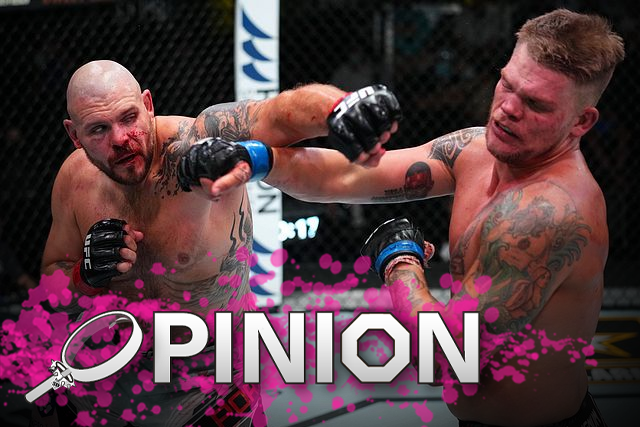Opinion: Whom is Most Modern MMA For?

John
Brannigan/Sherdog.com illustration
When considering the biggest differences between MMA now versus 20 years ago, most fans' first thought is the massive increase in fighter skill. Others think of how combat itself has evolved, or the change in top promotions, with Pride Fighting Championships and its unique ruleset gone. For me, it's the sheer number of fights. There were a total of seven Ultimate Fighting Championship events in 2002, a new record for the company. Each card featured eight or fewer bouts, for a total of 53 fights that year. Over in Japan, the greatest promotion of the early 2000s held six events in 2002, ignoring the amateur hour spinoff “Pride The Best” volumes 1-3. Each ranged between seven and nine bouts, meaning 47 fights in Pride that year. Adding the two, one needed to watch just 100 fights in 2002 to be up on all high-level MMA.
Advertisement
Who has the time and inclination to follow this much MMA, especially since so few of those fights are relevant to any world title? It's a question vital to the very structure of MMA promotions. All these fights certainly aren't for casuals. They only care about a few big showdowns a year. I've talked to them in meatspace, and at best they were aware of and wanted to watch Jon Jones vs. Ciryl Gane and Alexander Volkanovski vs. Islam Makhachev so far in 2023. However, this much MMA is not for the vast majority of hardcore fans, either. Those I know personally don't come close to watching even half the high-level MMA in a year. It's too much. This makes sense. Diehard NFL fans may watch five hours of American football in a given week, but the regular season is only 18 weeks, plus four weeks of postseason. A typical UFC card is over five hours and they occur over roughly twice as many weeks, 42. So that's over twice the commitment for watching the UFC alone, with no off-season to relax and become wistful about the sport again. Recall too the instance where Joe Rogan had no clue who Sijara Eubanks was when she was briefly booked to fight for the women's flyweight title in late 2018. Rogan is considered a hardcore fan, yet there was so much UFC content that he was unable to follow it all, despite working for the company. Incidentally, there are many times where other UFC color commentators have betrayed a lack of familiarity with fighters who had competed in the promotion multiple times, indicating that they too don't watch close to every match.
So again, who the hell is all this MMA for, even just the 500+ UFC
fights in a year? Obviously, there are people consuming it, or else
all the major organizations, the UFC included, would cut back
tremendously on the number of events and fights. There are four
groups that come to mind. Starting with the most niche:
MMA Journalists
Not every MMA journalist watches over 1,000 fights a year, but some get a lot closer than the average hardcore, if only because they provide coverage for major events. I'm a good example. Before working for Sherdog, I watched the majority of UFC and Bellator events, though not all of them. However, I have now watched extensive amounts of PFL and One thanks to my job, purely due to writing about them. This is a very small group and in no way explains our conundrum.
Degenerate Gamblers
When it comes to gambling, a Legacy Fighting Alliance prelim can be as lucrative as a UFC pay-per-view main event—possibly more so, since there is a good chance of it flying under the radar and thus having significant value. Gamblers will watch a very wide range of cards all the way down to the prelims in the hopes of finding a great line and the riches it offers. However, this is also a small group. There simply aren't enough people with the time and energy to approach MMA gambling as if it were a full-time job.
Friends and Family of the Fighters in Question
Now we're getting somewhere! This is a vastly larger group than the first two put together and is often underrated by MMA fans. Some fighters have hundreds of friends and family that buy tickets to watch them compete, a huge deal for any promotion. And obviously, friends and family are more excited to buy those tickets if the bout is in a major promotion. For one startling example, consider Israeli MMA pioneer Haim Gozali. Some wonder why Bellator has booked him so often, and occasionally on the main card. Well, it's because for one of their events, he sold 3,000 tickets by himself! In fact, people criticize Bellator for making unsigned fighters sell tickets, but it's the most natural idea in the world. Otherwise, Bellator would be losing money by paying prelim fighters thousands of dollars.
The UFC doesn't have to do this because it makes 20 times the revenue of Bellator, mostly from its broadcast agreement with ESPN, but even the UFC benefits from this group. Watch some of the early prelims on their non-Apex cards where the arena is still mostly empty and one will hear a lot of raucous cheering for a combatant. That's the friends and family who bought tickets.
However, it's not the main explanation, which goes to:
Heavy UFC Fight Pass and ESPN+ Consumers
Like it or not, the UFC is the industry leader. It holds 40-plus events a year with 13 fights per card and competitors have to follow suit or else risk fans forgetting about them. That's the fear if a promotion held an event every two months like they did in 2002. There would be about seven UFC events in-between there, and even if a fan skipped most of them, the UFC would capture their interest and imprint their brand far more effectively than the lone rival event. It's also why other promotions have moved to around 13 fights per card.
But why is the UFC doing this? Well, to satiate the subscribers to their two apps. It's the same mindset and calculations that Netflix does. The more hours of content they can generate, the better. And here's the key point that crystallizes everything; above a certain lower bound, the quality of the content barely matters. This is what Netflix discovered. The important part is how many hours of content their subscribers consume. Whether that's two hours of one of the greatest films ever or two hours of a trashy reality show matters slightly, but not much. Subscribers mostly judge the streaming service based on the number of hours they have spent and will spend. So long as the content held their interest and was acceptable viewing, it's fine.
Thus, the often-forgettable fights on UFC cards are vital content for their streaming services, offering countless hundreds of additional hours. And again, an hour of a random UFC Fight Night prelim is only slightly worse than an hour of a PPV main card. It's just grist for the mill, so if you've ever wondered who this much MMA is for, now you know. And the only way it will change is if the streaming service model implodes or goes away.
More




 Sherdog Opinion
Sherdog Opinion


